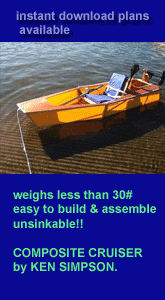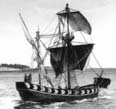
 Custom Search
|
| boat plans |
| canoe/kayak |
| electrical |
| epoxy/supplies |
| fasteners |
| gear |
| gift certificates |
| hardware |
| hatches/deckplates |
| media |
| paint/varnish |
| rope/line |
| rowing/sculling |
| sailmaking |
| sails |
| tools |
| join |
| home |
| indexes |
| classifieds |
| calendar |
| archives |
| about |
| links |
| Join Duckworks Get free newsletter CLICK HERE |
|
|
| The First American Ship |
by Stan Roberts - Round Rock, Texas - USA |
The first recorded ship built in America by English settlers was at the Popham settlement near the mouth of the Sagadahoc river in Maine about 1607. The Popham colony was established a few months after the Jamestown settlement in Virginia but only lasted approximately one year before being abandoned. The settlers at Popham were more sucessful than Jamestown in some important ways; they managed to build a substantial fort and a practical seagoing ship while keeping healthy, recording only one fatality. The colony was not abandoned due to lack of practical success. Colony leader George Popham died during the winter and his successor, Raleigh Gilbert, chose to return to England on the resupply ship in order to claim a family inheritance. The other colonists decided not to remain without a leader and returned with him.
The ship built at Popham was named “Virginia” or “Virginia of Sagadanoc”. Few details of the construction have survived in the historic records. A small sketch of the Virginia was included in an official construction drawing of Fort George, the settlement built at Popham. A copy of the map was stolen by the Spanish a year or so later and recently rediscovered at the government archives in Spain. The Virginia had an interesting career, completing two transatlantic voyages, one of which included surviving a hurricane force storm.
When the Jamestown and Popham colonies were established the entire Eastern seaboard of North America was refered to as Virginia, and entirely controlled by a private company, the Virginia Company. The first group of 120 colonists left Plymouth, England May 31, 1607 and arrived at the mouth of the Sagadahoc river (today the Kennebec) on August 13, 1607 aboard the ship “Gift of God”. A second ship, the “Mary and John” arrived on August 16th. Among the responsibilities assigned to the Popham colonists by their English sponsors was to prove that English ships could be built from new world forests. Construction of the settlement buildings was the obvious first priority, since they arrived at the end of the summer. The first winter in Maine was much colder and longer than the settlers had expected. It would have been possible for the boat builders to cut timber for the keel and framing in the fall of 1607 and do some shaping of major parts during the winter , along with making the sails, but it is likely that the actual building of the Virginia was started in the Spring of 1608. English shipbuilding at this time used carvel construction which called for the keel to be laid first, stem and sternposts attached, followed by a skeleton of frames and beams. Planks were nailed flush with each other with either iron nails or wooden trenails, and all seams were sealed with oakum caulking and overlaid with tar. Dimensions of the Virginia were:
The Virginia was an example of the pinnace design, which had great flexibility since it could be rigged for a variety of tasks such as offshore fishing, coastal exploration and trans-atlantic passages. In early records of New England watercraft the shallop and pinnace are recorded as the most common types. Shallops were generally smaller than the pinnace, but usually the same general shape and relatively narrow beam to move easily under sail and oar. The term pinnace was often more a reference to use than a type of design in the early 17th century. A pinnace was often towed by a larger ship and used for inshore work or offloading cargo and passengers. There was no standardization of pinnace design, they were constructed from 12 tons up to 40 tons. Generally they were more lightly built, single decked with flat stern, and usually with a greater length to beam ratio than larger ships. Pinnaces typically used oars or sweeps to move during calms or in harbors. Probably due to its versatility, the pinnace was a preferred small ship design in the first decades of English settlement of the New World. The Virginia's rig was adaptable to multiple different configurations depending on immediate purpose.
On Oct 17, 1608 Captain James Davis and 45 colonists abandoned Fort George, packed into the Virginia and returned to England. The rig used for this translatlantic passage was likely the square rig setup with gaff or lateen mizzen. The Virginia may have been the smallest ship to make a transatlantic passage at this time. For comparison, Columbus's smallest ship on his first voyage, the Nina, was 50-60 ton displacement at about the same LOA of approx. 50 ft but with more beam at 15' 9” and slightly more draft at 6' 8”.
The Virginia was obviously considered a well built and seaworthy little ship as it was later chosen to participate in Third Supply Fleet for the Jamestown colony. The Jamestown colony had some chronic problems due to a poorly chosen site and the selection of colonists was not based on any practical knowledge or skills. They had a surplus of gentlemen, ladies, playwrights, dilettantes, and soldiers but not enough carpenters, farmers and fishermen. In addition relations with the native people were usually bad, which made trade and food gathering difficult. The settlers were faced with starvation and disease throughout the early years, making re-supply from England essential. The Third Supply Fleet for Jamestown consisted of Virginia, a small ketch, and nine larger ships with a total of 500-600 people on board. They departed England in June 1609, following a more northerly course than usual in order to avoid hostile Spanish ships. The small ketch was towed by the 100 ft., 300 ton flagship “Sea Venture”, under joint command of Captain Newport and Admiral Somers. Sea Venture was one of the first English ships dedicated to emigration. The fleet encountered a serious three day storm, of hurricane force, after passing the Canary Islands. The Sea Venture was forced to cut the tow line and abandon the ketch during this storm in order to survive. The ketch went down with all hands, but the remainder of the fleet stayed afloat. The Sea Venture suffered serious damage, and was constantly leaking. Some accounts of the storm were recorded, “in the tayle of a Hericano wee were separated from the Admirall....some lost their masts, some their sayles blown from the yards, the seas over-raking our ships, much of our provision was spoyled, our fleet separated, our men sicke, and many dyed”. A passenger on the flagship later recounted “the ship in every joint having spewed out its oakum before we were even aware, was grown 5 feet deep with water above the ballast”. Running before the wind under bare poles, desperately bailing and pumping, and without a navigation sight for days the Sea Venture finally sighted land as the storm abated. Captain Newport deliberately beached the ship on the reef surrounding St. Georges Island, Bermuda in order to save the crew and passengers. The survivors of the wreck used a local cedar (very strong and light) along with parts from the Sea Venture to build two pinnaces, the “Patience” 29 ft. and “Deliverance” 60 ft. in the late fall of 1609 and Spring 1610. These were the second and third boat constructions in the New World English colonies. Patience and Deliverance set sail from Burmuda May 11, 1610 for Jamestown and arrived May 23 with 142 survivors of the Sea Venture. Two of the survivors are noteworthy; historian and author William Strachey, and botanist John Rolfe. Strachey wrote an account of the storm and wreck that was widely read in England. This account is generally considered to be the inspiration for Shakespeare's play The Tempest. John Rolfe carried tobacco seeds to Jamestown, and because of his selective breeding experiments established the American tobacco industry. He later married the well known native woman Pocahontas in 1614. There is no recorded account of the experiences of the Virginia during this storm. The Virginia , under Captain James Davis, likely suffered serious damage to rigging and sails and also had to run before the wind for days, just as the larger flagship did. It is known that the Virginia did not arrive at Jamestown until Oct 3, a full six weeks after the rest of the fleet which survived the storm. The delayed arrival may have been due to a combination of repairs, navigational errors, or possibly because Davis initially made landfall far to the North or South of Jamestown and took the opportunity to reprovision and explore parts of the coast.
In late Oct. 1609 Captain John Smith, the leader of Jamestown during the early years, returned to England with the Third Supply Fleet. It was noted at that time that a small fleet remained at Jamestown to service the colonies needs. Among these were the Virginia, seven smaller boats, and a canoe or two . The little ship finished out life as a multi-purpose craft for the colony, fishing and exploring the coastal areas. Virginia was a good practical design, and the first American boat built in the English colonies. She fulfilled her original purpose well, and proved that seaworthy ships could be built in the colonies of new world timber. ***** References:
|
To comment on Duckworks articles, please visit one of the following:
|
 |







